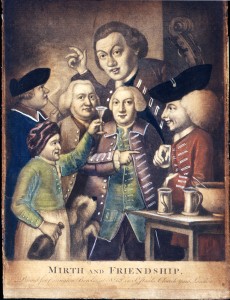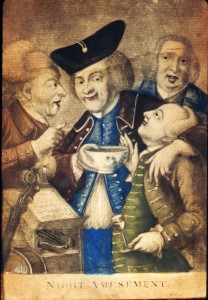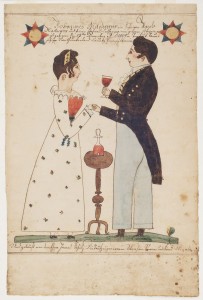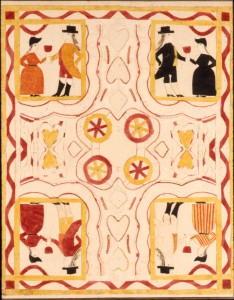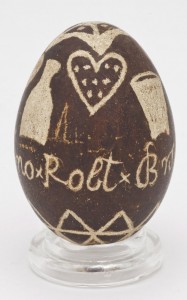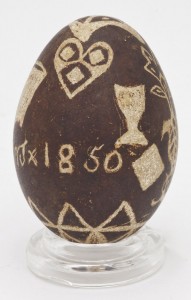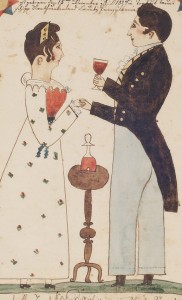 Throughout history, drinking has been a part of many public and private events for members of clubs, societies, and fraternal organizations. Some groups have even commissioned specially inscribed or symbolically ornamented punch bowls, decanters, or wineglasses for such occasions. From the mid-1700s onward inAmerica, locally made goods with special-order ornament were available in addition to imported types fromBritain, continental Europe, andChina. Although formal portraits rarely portrayed sitters with wine or other alcoholic beverages, a number of informal, often humorous, scenes do show cheerful groups of friends or club members sharing a punch bowl or glass of wine, or two, or three.
Throughout history, drinking has been a part of many public and private events for members of clubs, societies, and fraternal organizations. Some groups have even commissioned specially inscribed or symbolically ornamented punch bowls, decanters, or wineglasses for such occasions. From the mid-1700s onward inAmerica, locally made goods with special-order ornament were available in addition to imported types fromBritain, continental Europe, andChina. Although formal portraits rarely portrayed sitters with wine or other alcoholic beverages, a number of informal, often humorous, scenes do show cheerful groups of friends or club members sharing a punch bowl or glass of wine, or two, or three.
Private celebrations of friendship and important life events such as births, christenings, weddings, and even deaths were also often commemorated with wine and special-order objects. Coats of arms and affectionate phrases were inscribed on many drinking vessels. Grape clusters on beverage wares and other domestic objects symbolized health and Plenty.
Clubs & Other Organized Groups
[The] wisest institution ever made in drinking societies, is the custom of appointing what is called an absolute toast master. . . . It is particularly his office to name the toast, to observe that every man duly tosses off his bumper, and is in every respect good company. He is also to correct all misdemeanors [typically by forcing the offender to consume additional drinks].
Satirical article discussing London’s drinking clubs,
in Connoisseur (London), February 27, 1755
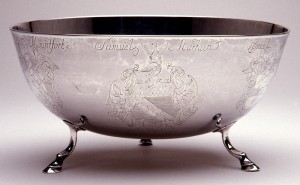 Punch bowl
Punch bowl
John Burt
Boston, Massachusetts; 1740–45
Silver
Museum purchase in honor of Donald L. Fennimore, with funds provided in part by Mr. Denison H. Hatch, The Hohmann Foundation, Mr. and Mrs. P. Coleman Townsend, Jr., Mr. and Mrs. John L. McGraw, Dr. Richard C. Weiss and Dr. Sandra R. Harmon-Weiss, Mr. and Mrs. Richard W. Vieser, and other friends 2004.52
This handsome vessel is exceptional in that it is supported on three legs rather than on a round pedestal. Extraordinary also are the six coats of arms with the names of the owners—all of whom lived in Boston—engraved around the body. The reason these men had the bowl made remains a mystery. One theory is that they drank punch from it during social or business gatherings.
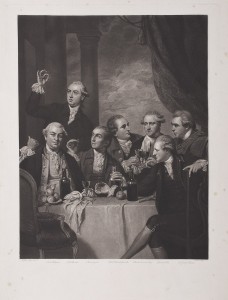 Members of the Society of Dilettanti
Members of the Society of Dilettanti
Charles Turner, after Sir Joshua Reynolds
London, England; about 1830
Ink on paper
Gift of Frank Henry Sommer, Ph.D. 2004.68.35
The famous London dining club known as the Society of Dilettanti, which first convened in 1732, still exists today. Initially its membership included noblemen who had traveled the Continent on the Grand Tour and took an interest in Greek and Roman antiquities. Although occasionally lampooned as a drinking club, the intentions of the group are scholarly, and eventually membership broadened to include famous members of society such as artist Sir Joshua Reynolds and David Garrick, one of the most highly respected 18th-century English actors. (For another print portraying the Dilettanti, see Classical Vessel Forms.)
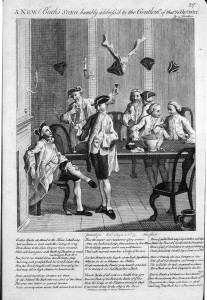
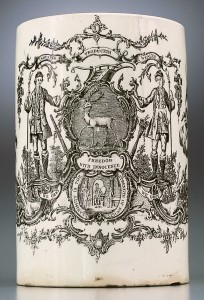 A New Buck’s Song
A New Buck’s Song
Robert Sayer
London, England; 1756
Ink on laid paper
Bequest of Henry Francis du Pont 1969.1772a,b
Mug and punch bowl with arms of the Society of Bucks
Probably Staffordshire, England; 1757‒70 (earthenware [creamware] mug)
Jingdezhen, China; 1757‒70 (porcelain bowl)
Gift of Leo A. and Doris C. Hodroff 2003.47.10, .11
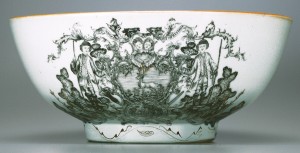 England’s Society of Bucks met at a number of pubs in London and in Liverpool, where records for that branch of the society survive from 1723 to 1802. The group seems to have gathered for casual entertainment, but its mottos “INDUSTRY PRODUCETH WEALTH” and “FREEDOM WITH INNOCENCE” suggest a sense of social consciousness. The humorous print shows society members sharing a bowl of punch below a buck’s skull; the poem speaks of the range of members and their love of women and drink.
England’s Society of Bucks met at a number of pubs in London and in Liverpool, where records for that branch of the society survive from 1723 to 1802. The group seems to have gathered for casual entertainment, but its mottos “INDUSTRY PRODUCETH WEALTH” and “FREEDOM WITH INNOCENCE” suggest a sense of social consciousness. The humorous print shows society members sharing a bowl of punch below a buck’s skull; the poem speaks of the range of members and their love of women and drink.
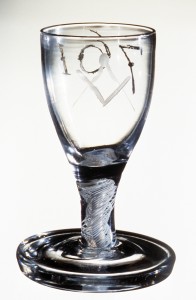 Firing glass with masonic symbols
Firing glass with masonic symbols
Ireland or England; about 1795
Glass (lead)
Inscribed “761”
Gift of Mrs. Hugh W. Kelly 1987.125
Masonic flask
New England Glass Company or New England Glass Bottle Company
Cambridge, Massachusetts; 1818–30
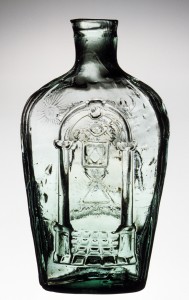 Glass (nonlead)
Glass (nonlead)
Inscribed “NE / CO”
Museum purchase 1982.322
Heavy-stemmed and footed “firing glasses” like the one shown here were used during toasts at Masonic meetings and other events. Pounding the glass on a tabletop created an applause-like sound resembling gunfire. The engraved “761” refers to the Young-Union Lodge in Ireland. Masonic glasses in America are known as early as 1761, when they were advertised in the Boston Gazette. Some were produced domestically, as indicated by a 1772 ad in the Pennsylvania Gazette for William Henry Steigel’s glassware, including “enamelled” and “twisted mason wines.” The compass and square motif on the firing glass reappears with other Masonic emblems on the less-costly flask, which displays a large American eagle on the reverse.
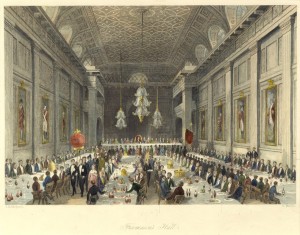 Freemason’s Hall . . . Dinner of the Royal Humane Society
Freemason’s Hall . . . Dinner of the Royal Humane Society
Thomas Hosmer Shepherd
London, England; 1842
Ink, watercolors on paper
Museum purchase 1967.200
London’s Royal Humane Society was established in 1774 to “collect and circulate the most approved and effectual methods for recovering persons apparently drowned, or dead from any other cause; and to suggest and provide suitable apparatus for, and bestow rewards on, those who assist in the preservation and restoration of life.” At the annual banquet of the society, individuals who have saved lives joined Bible-carrying “saved persons” in a procession preceded by banners, one inscribed “WE PRAISE GOD & THANK YOU.” The paraders were instructed to wear their everyday clothes. As is evident in the print, ample wine was served to society members but not the paraders.
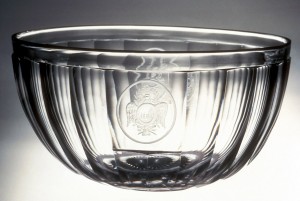
Punch bowl and ale glass with Society of the Cincinnati emblem
France; 1855–85
Glass (lead)
Bequest of Henry Francis du Pont 1961.630.2–.3
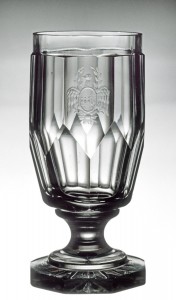 The Society of the Cincinnati was founded in 1783 in partto help preserve the fellowship and ideals inspired by the American Revolution. Glass beverage wares associated with the group, shown here, are part of a large service acquired by Henry Francis du Pont from antiques dealer J. A. Lloyd Hyde. Found in Bermuda, the set includes 11 ale glasses, 12 champagne glasses, 14 water goblets, and a pair of decanters. The service may have been made around 1876 for the upcoming centennial of America’s initial steps toward independence.
The Society of the Cincinnati was founded in 1783 in partto help preserve the fellowship and ideals inspired by the American Revolution. Glass beverage wares associated with the group, shown here, are part of a large service acquired by Henry Francis du Pont from antiques dealer J. A. Lloyd Hyde. Found in Bermuda, the set includes 11 ale glasses, 12 champagne glasses, 14 water goblets, and a pair of decanters. The service may have been made around 1876 for the upcoming centennial of America’s initial steps toward independence.
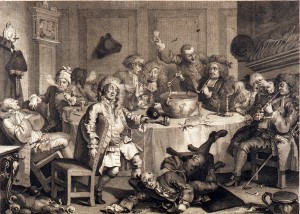 A Midnight Modern Conversation
A Midnight Modern Conversation
William Hogarth
London, England; about 1733
Engraving on laid paper
Gift of Gordon A. Rust 1975.219
Punch bowl
Probably Liverpool, England; 1750–70
Earthenware (delftware)
Museum purchase with funds provided by  Mr. and Mrs. John Mayer and Mrs. Lammot du Pont Copeland 1984.30
Mr. and Mrs. John Mayer and Mrs. Lammot du Pont Copeland 1984.30
The popular Midnight Modern Conversation print satirized drinking clubs and was first published by William Hogarth in London in 1732/33. It was also available for purchase in America. One 1755 Pennsylvania Gazette advertisement offered newly imported “midnight conversation” prints for sale by Alexander Hamilton on Philadelphia’s Water Street. In 1810 Minister William Bentley visited a descendant of Massachusetts Governor J. L. Philips and was shown a “‘punchbowl of Delft’ decorated with A Midnight Modern Conversation.”
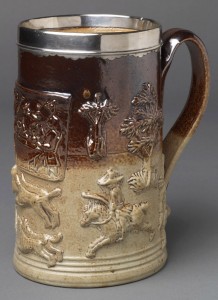 Mug or tankard
Mug or tankard
Probably Kishere factory
Mortlake (near London), England; about 1800
Stoneware (salt-glazed), silver
Museum purchase with funds provided by the Claneil Foundation 1975.113
 The scene on this mug is traditionally referred to as “The Punch Party,” and some versions may have been inspired by Hogarth’s print. Relief-decorated brown stoneware mugs were popular in middling-income homes and taverns in Britain and America from the early 1700s onward. The costly silver rim on this one may cover chips and indicates that the owner prized the vessel.
The scene on this mug is traditionally referred to as “The Punch Party,” and some versions may have been inspired by Hogarth’s print. Relief-decorated brown stoneware mugs were popular in middling-income homes and taverns in Britain and America from the early 1700s onward. The costly silver rim on this one may cover chips and indicates that the owner prized the vessel.
Friendship & Well-Wishing
Some bloods being in company with a celebrated fille de joy, one of them pulled off her shoe, and in an excess of gallantry filled it with Champagne, and drank it off to her health . . . and then, to carry the compliment still further, he ordered the shoe itself to be dressed and served up for supper. The cook set himself seriously to work upon it; he pulled the upper part (which was of damask) into fine shreds, and tossed it up in a ragout; minced the sole; cut the wooden heel into very thin slices, fried them in batter, and placed them round the dish for garnish. The company . . . testified their affection for the lady by eating very heartily of this exquisite impromptu.
Connoisseur (London), June 6, 1754
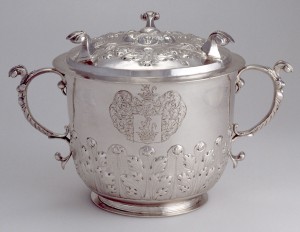 Cup with arms of Philipse family
Cup with arms of Philipse family
Jurian Blanck Jr.
New York, New York; about 1690
Silver
Inscribed “ICE”
Gift of Henry Francis du Pont 1959.2298a,b
Elegant silver vessels like the cup shown here were often shared communally. On this example the lid has three feet and can be inverted to function as a stand. The initials and family coat of arms of Jacobus and Eva Van Courtland indicate the vessel may have been commissioned to celebrate their marriage in 1691. Jacobus was a successful merchant and served twice as mayor of New York. Eva’s father, Frederick Philipse, was among the wealthiest men in the region.
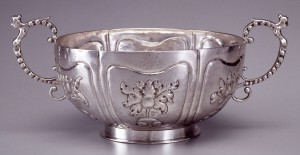 Drinking bowl (brandewijnskom)
Drinking bowl (brandewijnskom)
Jacob C. Ten Eyck
Albany, New York; about 1735
Silver
Inscribed “EWE”
Gift of Charles K. Davis 1955.127
The floral-panel drinking bowl is a type that was popular in Albany and New York City through the early 1700s. It imitates brandewijnskom, which were used at christenings and weddings to serve a punch-like drink of brandy and raisins that was eaten with silver spoons. This bowl is initialed for Evert and Englette (Lansing) Wendell of Albany. Evert, a lawyer, served as Commissioner of Indian Affairs. The bowl was the inspiration for the design of the Henry Francis du Pont Challenge Trophy, which is presented at Winterthur’s annual Point-to-Point races.
MIRTH AND FRIENDSHIP and NIGHT AMUSEMENT
Carington Bowles
London, England; 1750–75
Hand-colored mezzotint on laid paper
Gift of George H. Blackshire 1987.42.2a,b, .1a,b
The waiter in the foreground of MIRTH AND FRIENDSHIP suggests that this scene is set in a tavern. The unusual dog and oversize man—perhaps Edward Bamfield “The Staffordshire Giant” who performed at London’s Covent Garden—indicate that a particular group of friends is being satirized. The mate to this print, Night Amusement, shows some of the same men with a punch bowl and musical instruments. Here, Bamfield is shown in a tricorn hat. Another man illustrates the popular way of holding a wineglass by the base.
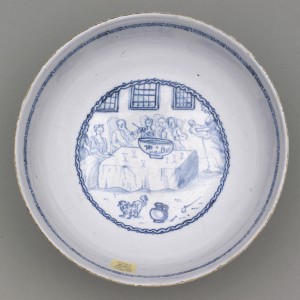

Punch bowl
Probably London, England; dated 1752
Earthenware (delftware)
Inscribed “IBM / 1752”
Museum purchase with funds provided by the Henry Francis du Pont Collectors Circle 2011.7.3
The festive scene within this rare, footed punch bowl may celebrate the christening of a child born to the couple whose initials are on the base of the vessel. (Perhaps less likely, the dog, jug,and broken pipes on the floor are a reference to debauchery.) The exterior shows an unusually well-executed rural landscape scene featuring a tavern or inn.
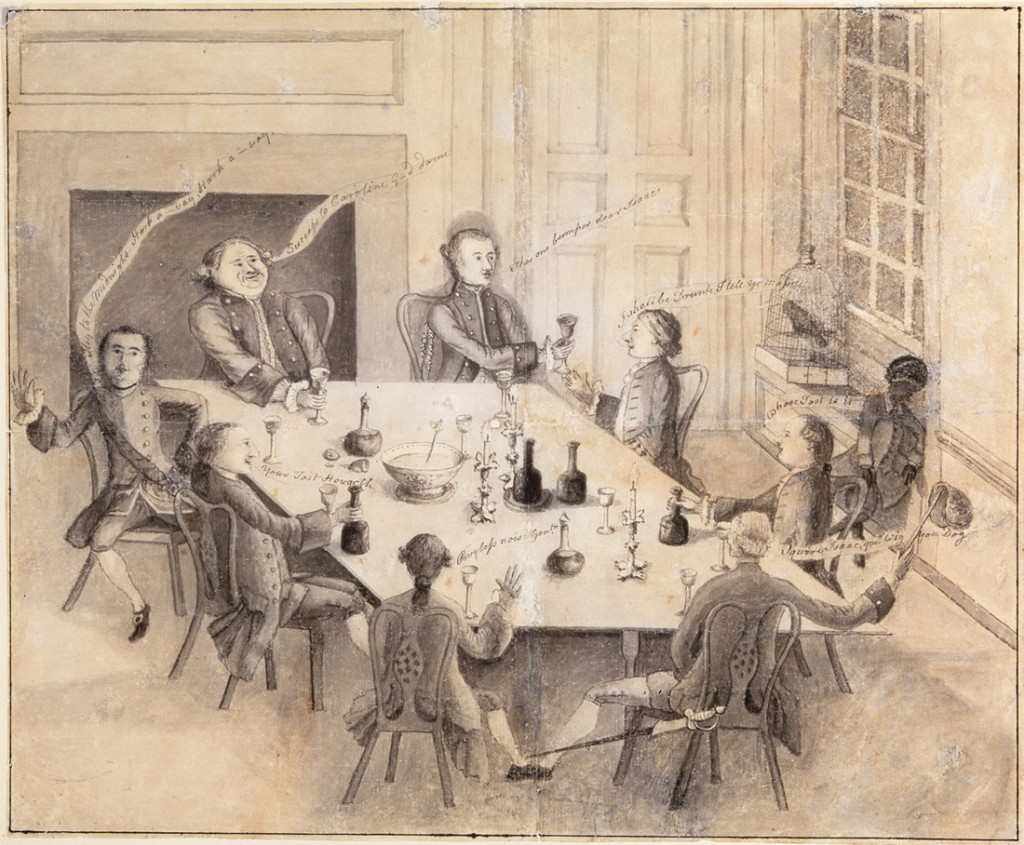 Peter Manigault and His Friends
Peter Manigault and His Friends
George Roupell
Charleston, South Carolina; 1760–76
Ink drawing with graphite and wash on laid paper
Museum purchase 1963.73
Among the best-known drawings from the Winterthur collection is this cheerful, informal scene of an evening’s entertainment hosted at Steepbrook, the home of Peter Manigault, a member of a wealthy Charleston family and Speaker of the Commons House of Assembly. The view includes five military men, Manigault, his neighbor Isaac Godin (a prosperous merchant and planter), artist George Roupell, and a young African servant. The table displays wineglasses, bottles, fashionable decanters, a punch bowl, and a ladle. The text near the men’s heads offers toasts, complaints of drunkenness, and other humorous remarks.
 Charity in the Cellar
Charity in the Cellar
Leney (engraver), after William Hogarth
London, England; 1837
Stipple engraving on wove paper
Winterthur Museum 1973.560
This scene of friends partying in a cellar includes many alcoholic beverage-related objects. Large and small wine casks or barrels are sprinkled around the room. Some wine bottles are wrapped in protective woven canework, making them suitable for traveling, and in the foreground a punch bowl is in somewhat unorthodox use. Charity, represented (right) by a small figure group showing a mother suckling children, is imitated in pose by the group of men in the foreground.
Birth and baptismal certificate
Henry Young
Turbot Township, Northumberland County, Pennsylvania; 1827–40
Ink, watercolor on wove paper
Museum purchase with funds provided by Henry Francis du Pont 1958.120.20
The Pennsylvania German birth and baptismal certificate (Geburts und Taufschein), portraying a couple sharing a glass of wine, is for Johannes Machemer, who was born on December 15, 1827, in Turbot Township. He was baptized by Jared Schutz, with Abraham Sterner and his wife, Maria, as sponsors. The fashionable dress, table, wine decanter, and glass reappear with different details on other certificates.
Cutwork picture (Scherenschnitte) or fraktur
Pennsylvania; 1810‒50
Ink, watercolor on wove paper
Bequest of Henry Francis du Pont 1957.1206a,b
In the corners of this cutwork picture, couples raise wine-filled glasses, perhaps to celebrate a special occasion.
Easter egg
Southeastern Pennsylvania; dated 1850
Inscribed “Jno Robt Brs 1850”
Gift of Jane and Gerald Katcher 2011.35
Pennsylvania Germans created Easter eggs like this one by hard boiling them with onion skins and then scratching in designs. This rare survival portrays a decanter, two wineglasses, and a tumbler. The egg was presumably decorated to celebrate a special occasion, or it might have been made as a gift for “Jno Robt Brs.” Decorated goose eggs of this type were sometimes displayed in rye-straw baskets.
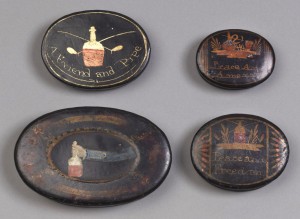 Tobacco or snuff boxes
Tobacco or snuff boxes
England; 1815–50
Tinned sheet iron, paint
Inscribed “A Friend and Pipe,” “Peace andAmerica,” “Peace and Freedom,” “Love and fortune / Favour the resolute”
Bequest of Henry Francis du Pont 1965.1567a,b, .1569a,b, .1801a,b, .1803a,b
Boxes for tobacco or snuff (powdered tobacco typically inhaled through the nose) were popular from the late 1600s onward and were made in many materials, from metal to horn or pressed board. The decoration on such boxes varies across cultural boundaries, from decorative flowers to political and religious symbols or slogans. The examples shown here feature drinking vessels with red wine along with brief toast-like phrases expressing affection or patriotism.
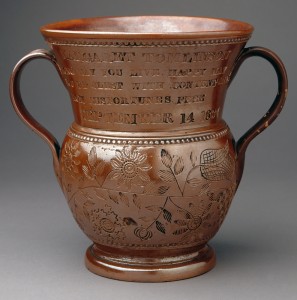 Oversize cup
Oversize cup
Nottingham, Nottinghamshire, or Chesterfield, Derbyshire, England; dated September 14, 1837
Stoneware
Inscribed “MARGARET TOMLINSON / LONG MAY YOU LIVE HAPPY MAY / YOU BE BLEST WITH CONTENT AND / FROM MISFORTUNES FREE / SEPTEMBER 14 1837.”
Gift of Mrs. Alfred C. Harrison 1969.388
Large ceramic “loving cups” were made in many forms. Although popular with nearly all levels of society in the 1600s and early 1700s, by the 1800s they were found mainly in traditional and middling-income settings. The one shown here was made a gift for Englishwoman Margaret Tomlinson. The inscription was created by pressing printer’s-type letters into the clay.
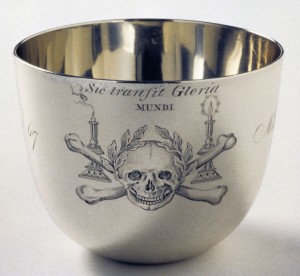 Tumbler
Tumbler
Joseph and Nathaniel Richardson
Philadelphia, Pennsylvania; dated 1790
Silver
Inscribed “Sic transit Gloria / MUNDI” and “Magdalen Swift died 27th March 1790 – aged 67”
Gift of Marshall P. Blankarn 1977.78
Drinking vessels commemorating deaths are quite rare. This elegantly engraved tumbler, a form popular around 1800, honors Magdalen Swift, a member of a prominent Delaware family. Swift’s second husband served as collector at the Port of Philadelphia. On the tumbler, a laurel-wreath skull and cross bones is flanked by a pair of candlesticks; one has a shorter candle that was recently extinguished. The Latin phrase translates as “How swiftly passes the glory of this world.”
Related Themes:

